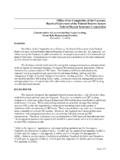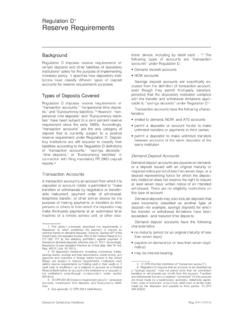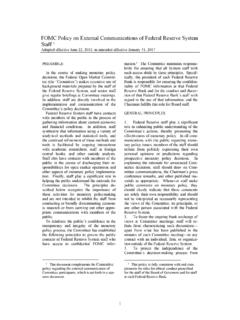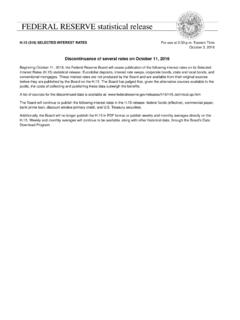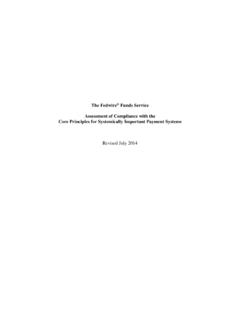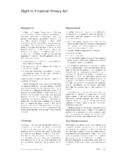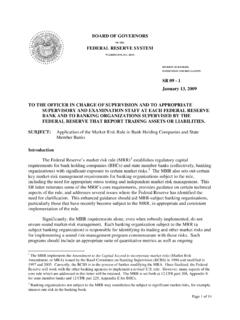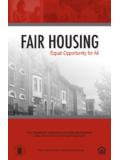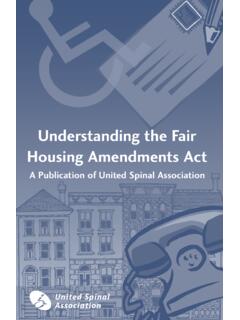Transcription of and Fair Housing Act - Federal Reserve
1 Federal fair Lending Regulations and Statutes fair Housing Act The fair Housing Act (FHAct), which is title VIII of the Civil Rights Act of 1968, as amended (42 USC 3601 et seq.), makes it unlawful for any lender to discriminate in its Housing -related lending activities against any person because of race, color, religion, national origin, sex, handicap, or familial status. Anyone who is in the business of providing Housing -related loans is subject to the FHAct (as well as the Equal Credit Opportunity Act). Key Provisions of the fair Housing Act The fair Housing Act specifically applies to the financing of a loan secured by residential real estate. As noted in section 805 of the act, a bank may not deny a loan or other financial assistance for the purpose of purchasing, constructing, improv ing, repairing, or maintaining a dwelling because of the race, color, religion, national origin, handicap, familial status, or sex of the Loan applicant Any person associated with the loan applicant Any current or prospective owner of the dwelling Any lessees Any tenants or occupants The FHAct also makes it unlawful for a creditor to use a prohibited basis to discriminate in fixing the amount, interest rates, duration, or other terms of the credit.
2 In addition, because residential real estate related transactions include any transac tions secured by residential real estate, the act s prohibitions (and regulatory requirements in certain areas, such as advertising) apply to home equity lines of credit as well as to home purchase loans. These prohibitions also apply to the selling, renting, brokering, or appraising of residential real property and to secondary-mortgage-market activities. Con sequently, a bank s practices in the area of Housing lending should be examined in a general way to ensure that they do not otherwise make unavail able or deny Housing , even when no specific act or practice may violate any specifically named prohibition of the FHAct.
3 Unlawfully Discriminatory Lending Practices under the FHAct Like the other civil rights statues, the fair Housing Act was broadly written by Congress. A variety of lending practices have been found to be illegal under the act, including some that are not specifi cally mentioned in the act but that have been determined to be illegal because they violate requirements and prohibitions that are implicit in the act s language. Some of the practices that the courts have determined to be prohibited are described below. Redlining Redlining is the practice of denying a creditworthy applicant a loan for Housing in a certain neighbor hood even though the applicant may otherwise be eligible for the loan. The term refers to the presumed practice of mortgage lenders of drawing red lines around portions of a map to indicate areas or neighborhoods in which they do not want to make loans.
4 Redlining on a racial basis has been held by the courts to be an illegal practice. It is unlawful under the FHAct only when done on a prohibited basis. Redlining an area on the basis of such consider ations as the fact that the area lies on a fault line or a flood plain is not prohibited. The prohibition against redlining does not mean that a lending institution is expected to approve all Housing loan applications or to make all loans on identical terms. Denying loans or granting loans on more-stringent terms and conditions, however, must be justified on the basis of economic factors and without regard to the race, color, religion, national origin, sex, or marital status of the prospective borrowers or the residents of the neighborhood in which the property is located.
5 For example, a bank may consider such economic factors as An applicant s income or credit history The condition, use, or design of the proposed security property (or of those nearby properties that clearly affect the value of the proposed security property), provided that such determi nants are strictly economic or physical in nature The availability of neighborhood amenities or city services The need of the lender to hold a balanced real estate loan portfolio, with a reasonable distribu tion of loans among various neighborhoods, types of property, and loan amounts Each of the factors must be applied without regard to any of the prohibited bases. Consumer Compliance Handbook FHAct 1 (1/06) fair Lending: fair Housing Act Lowballing Lowballing the practice of making an excessively low appraisal in relation to the purchase price on the basis of prohibited considerations is one form of redlining.
6 Lending more than the appraised value of the collateral is not sound banking practice, and lowballing forces a borrower either to cancel the purchase contract or the loan application, or both, or to make a larger down payment on a property in order to make up the difference between the sales price and the appraised price. Use of Racially Exclusive Images The use of racially exclusive images has repeat edly been found to be illegal in the employment context even when there was little or no evidence of a discriminatory policy directed toward any given individual applicant. This practice has been held to violate the fair Housing Act as well. For example, a Housing lender might exploit an exclu sive image by showing only applicants of a particular race in advertisements for home loans.
7 Using only white individuals in advertisements for home equity loans, for instance, may suggest to viewers that only white applicants need apply or that the lender is looking only for applicants who resemble the individuals in its Housing advertisements. In addition to prohibiting the use of racially exclusive images, the FHAct makes it unlawful to make or print a statement or advertisement with respect to the sale or rental of a dwelling that indicates a preference, limitation, or discrimination based on race, color, religion, sex, handicap, familial status, or national origin or the intention to make any such preference, limitation, or discrimi nation. The courts have applied this prohibition to newspaper advertisements soliciting tenants and homebuyers who speak only certain languages.
8 For example, a Korean bank that advertises only in Korean-language publications targeting Koreans while ignoring other minority groups in the bank s community may be discouraging other minority applicants from applying. Although it is recognized that a determination of the impact of an advertising policy will depend on all the facts of the situation, some advertising guidelines issued by the Secre tary of the Department of Housing and Urban Development may be useful to banks and exam iners in determining the kinds of advertising practices that should be encouraged or avoided. Banks should ensure that their advertising policies do not have the effect, even inadvertently, of prescreening applications for credit on prohibited bases.
9 2 (1/06) FHAct Consumer Compliance Handbook Discriminatory Acts That Have a Negative Impact on Nonminorities The courts have held that discriminatory acts that have a negative impact on nonminorities, such as white individuals, are illegal and that such individu als have standing to sue. Use of Excessively Burdensome Qualification Standards The use of excessively burdensome qualification standards to deny, or that have the effect of denying, Housing to minority applicants is also illegal under the FHAct. Imposition of More-Onerous Interest Rates or Other Terms, Conditions, or Requirements The imposition of more-onerous interest rates, or other more-onerous terms, conditions, or require ments, on minority loan applicants is explicitly prohibited.
10 The phrase terms or conditions as used in the act covers many types of discriminatory practices. Application of Different Standards or Procedures for the Same Process The application of different standards or proce dures in administering foreclosures, late charges, penalties, reinstatements, or other collection proce dures is unlawful. Insurance The FHAct and the ECOA diverge on the treatment of discrimination in the terms or availability of insurance. The ECOA does not prohibit a creditor who sells or participates in the sale of insurance from differentiating, on a prohibited basis, in the terms and availability of insurance. Nor does it prohibit discrimination in the availability or terms of credit on the basis that insurance is unavailable, except when the insurance has been denied on the basis of age.
